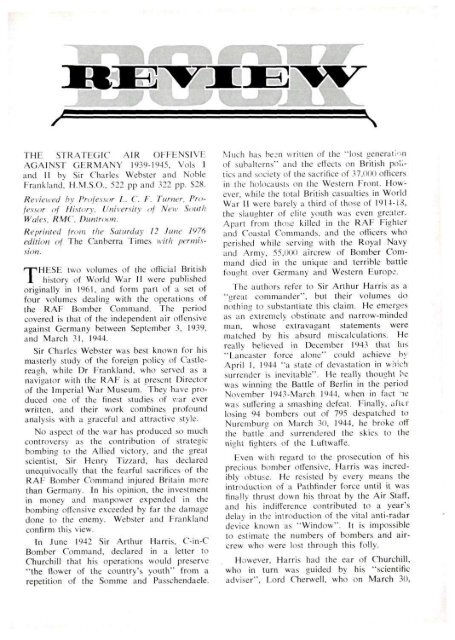ISSUE 1 : Nov/Dec - 1976 - Australian Defence Force Journal
ISSUE 1 : Nov/Dec - 1976 - Australian Defence Force Journal
ISSUE 1 : Nov/Dec - 1976 - Australian Defence Force Journal
You also want an ePaper? Increase the reach of your titles
YUMPU automatically turns print PDFs into web optimized ePapers that Google loves.
• \THE STRATEGIC AIR OFFENSIVEAGAINST GERMANY 1939-1945. Vols Iand II by Sir Charles Webster and NobleFrankland, H.M.S.O., 522 pp and 322 pp. S28.Reviewed by Professor /.. C. F. Turner, Professorof History, University of New SouthWales, RMC , Duntroon.Reprinted from the Saturday 12 June 1^76edition of The Canberra Times with permission.THESE two volumes of the official Britishhistory of World War II were publishedoriginally in 1961, and form part of a set offour volumes dealing with the operations ofthe RAF Bomber Command. The periodcovered is that of the independent air offensiveagainst Germany between September 3, 1939,and March 31. 1944.Sir Charles Webster was best known for hismasterly study of the foreign policy of Castlereagh.while Dr Frankland, who served as anavigator with the RAF is at present Directorof the Imperial War Museum. They have producedone of the finest studies of war everwritten, and their work combines profoundanalysis with a graceful and attractive style.No aspect of the war has produced so muchcontroversy as the contribution of strategicbombingto the Allied victory, and the greatscientist. Sir Henry Tiz/ard, has declaredunequivocally that the fearful sacrifices of theRAF Bomber Command injured Britain morethan Germany. In his opinion, the investmentin money and manpower expended in thebombing offensive exceeded by far the damagedone to the enemy. Webster and Franklandconfirm this view.In June 1942 Sir Arthur Harris, C-in-CBomber Command, declared in a letter toChurchill that his operations would preserve"the flower of the country's youth" from arepetition of the Somme and Passchendaele.Much has been written of the "lost generationof subalterns" and the effects on British politicsand society of the sacrifice of 37,000 officersin the holocausts on the Western Front. However,while the total British casualties in WorldWar II were barely a third of those of 1914-13,the slaughter of elite youth was even greater.Apart from those killed in the RAF Fighterand Coastal Commands, and the officers whoperished while serving with the Royal Navyand Army, 55,000 aircrew of Bomber Commanddied in the unique and terrible battlefought over Germany and Western Europe.The authors refer to Sir Arthur Harris as a"great commander", but their volumes donothing to substantiate this claim. He emergesas an extremely obstinate and narrow-mindedman, whose extravagant statements werematched by his absurd miscalculations. Hereally believed in <strong>Dec</strong>ember 1943 that his"Lancaster force alone" could achieve byApril 1, 1944 "a state of devastation in whichsurrender is inevitable". He really thought hewas winning the Battle of Berlin in the period<strong>Nov</strong>ember 1943-March 1944, when in fact "lewas suffering a smashing defeat. Finally, afterlosing 94 bombers out of 795 despatched toNuremburg on March 30, 1944, he broke offthe battle and surrendered the skies to thenight fighters of the Luftwaffe.Even with regard to the prosecution of hisprecious bomber offensive, Harris was incrediblyobtuse. He resisted by every means theintroduction of a Pathfinder force until it wasfinally thrust down his throat by the Air Staff,and his indifference contributed to a year'sdelay in the introduction of the vital anti-radardevice known as "Window". It is impossibleto estimate the numbers of bombers and aircrewwho were lost through this folly.However, Harris had the ear of Churchill,who in turn was guided by his "scientificadviser", Lord Cherwell, who on March 30,
















